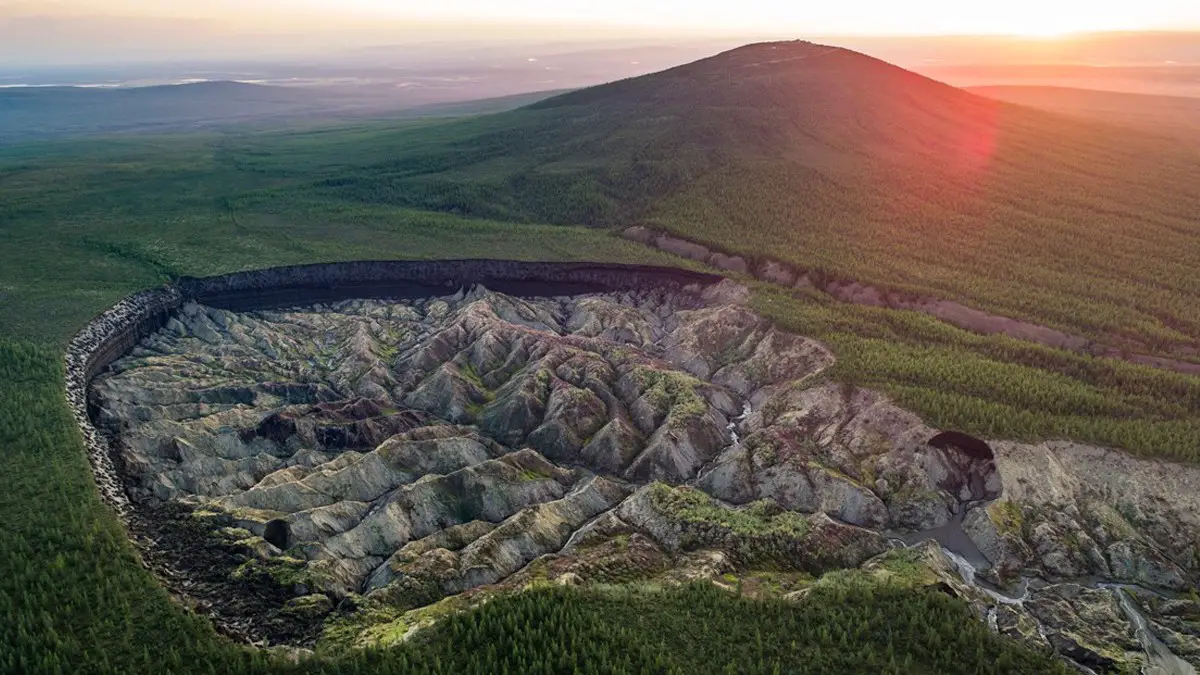 iberia is the host to some of the world’s strangest locations as far as natural sightings go. Lake Baikal, also known as the first lake and one of the deepest lakes on our planet used takes the cake, but Batagaika crater, also nicknamed the “mouth to hell” crater is not very far off.
iberia is the host to some of the world’s strangest locations as far as natural sightings go. Lake Baikal, also known as the first lake and one of the deepest lakes on our planet used takes the cake, but Batagaika crater, also nicknamed the “mouth to hell” crater is not very far off.
Despite its intricate shape, it does not look like there is something special with it. Despite being one of the very few, as well as the largest permafrost crater in the world. Not to forget mention that it is also the only crater that has been constantly expanding for the past 60 years.
History of Batagaika Crater
The crater started to form back in the 1960s after parts of the massive Siberian forests have been cleared out. The land was held up due to the permafrost soil, as well as the lack of contact with humanity. The tall trees standing close to one another were shading the frozen ground from the sun.
With some of the trees cut down and the increase in average temperature over time due to global warming, the permafrost started to melt. Usually, craters are formed by meteors that hit the earth, but permafrost craters form by an explosion caused by pockets of air stuck between the frozen ground.
Seeing a crater that keeps on expanding is a whole different story. During the early creation or better-said expansion of the Batagaika crater, scientists exploring the area didn’t really pay much attention to its expansion. It was not necessarily a lack of attention, but the slow expansion rate that contributed to this.
Taking into consideration that there isn’t much information on the crater prior 1980s, it is uncertain actually how many people were aware that a natural shift is taking place. Scientists that have recently been analyzing the inside of the mouth have found that this is actually a gate, not to hell (as much as we are aware) but a gate to a natural database holding years of climate data.
The crater does a great job at painting the picture of how global temperature has risen over the years which is also correlated to the growth and expansion of the crater. The data that has been exposed through the layers of soil is over 200,000 years old, although the lower layer may actually be 650,000 years old.
Siberia’s Gate To Hell expanding
From nothing, the crater has managed to expand shy of 1 kilometer long (0.6 miles) and 86 meters (262 feet) deep. You can see from the image above that a major spike had occurred in the 1940s, this may have also been the spike that caused the creation of the crater.
The 1940s is very significant due to the high increase in fuel consumption which was mainly caused by the II World War. An effect of the industrial revolution set to overtime, due to the high production of ammunition and weaponry, a manufacturing process that resorts to burning a lot of fossil fuels, creating carbon dioxide which leads to a shift in global temperature.
Since the 1960s there has been a constant rise which has also affected the global temperature. We all know the story about how global warming takes place, so I will not bore you with the details, but what is imperative to note is that everything that occurs within nature can be calculated with data.
During the 1980s the crater started expanding by 10 meters per year. In recent years the expansion had evolved to 30 meters per year. If you think about it, you can literally go to the crater every day with a ruler and measure a somewhat obvious change.

Based on the footage recorded by NASA satellites over years, we can see how quickly the crater has been expanding. The first image is from 1985 when the crater was more like a long mount. The second image is from 2013 and the last one is from 2021. The comparison of expansion between 1985 to 2013 and between 2013 to 2021 is significant.
Will this expansion ever stop?
The increase in the pace of expansion is clear and this will most probably be nothing compared to what the expansion could look like in 2030 when the global temperature will reach 1.5°C.
Scientists say that it was the permafrost that stopped the expansion of the crater until the 1960s. The more interesting question to ask is what other craters are waiting to be unleashed once the permafrost dissipates in other parts of the world. We are in a race to combat climate change, one that we think we can make a comeback, but we don’t know that we cannot outpace nature.
As far as the science behind this phenomenon goes, the expansion of the crater cannot be stopped and it may even increase to the point where the expansion rate will be so quick, that it will cause disruption with the tectonic plates, causing major earthquakes.
The crater is set on a trajectory to eat and engulf everything in its vicinity, with no way of being stopped. Despite how technologically advanced we may get, we will never be able to stop nature.
Avid Writer with invaluable knowledge of Humanity!
Upcoming historian with over 30 million views online.
“You make your own life.”





